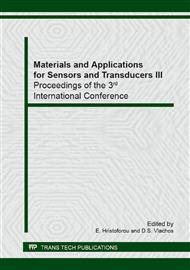[1]
P. A. Rodnyi, "Physical Processes in Inorganic Scintillators", CRC Press, 1997.
Google Scholar
[2]
L. Fonda et al., "Decay theory of unstable quantum systems", Rep. Prog. Phys. 41, 587 (1978).
Google Scholar
[3]
L.E. Ballantine, "Quantum Mechanics", Prentice Hall, Englewood Cliffs (1990).
Google Scholar
[4]
E. Merzbacher, "Quantum Mechanics (1st edition)", John Wiley and Sons, Inc., New York (1961).
Google Scholar
[5]
F.M. Dittes, "The decay of quantum systems with a small number of open channels", Phys. Rep. 339, 215 (2000).
DOI: 10.1016/s0370-1573(00)00065-x
Google Scholar
[6]
K.J.F. Gaemers and T.D. Visser, "Deviations from exponential decay in quantum mechanics", Physica A 153, 234 (1988).
DOI: 10.1016/0378-4371(88)90004-0
Google Scholar
[7]
A. Scordino et al., "J. Photochem. Photobiol.", 56, 181 (2000).
Google Scholar
[8]
L. Brizhik et al., "Delayed luminescence of biological systems arising from correlated many-soliton states", Phys. Rev. E 64, 031902 (2001).
DOI: 10.1103/physreve.64.031902
Google Scholar
[9]
F.-A. Popp and K. Li, "Hyperbolic Relaxation as a Sufficient Condition of a Fully Coherent Ergodic Field", Int. J. Theor. Phys., 32, 1573 (1993).
DOI: 10.1007/bf00672857
Google Scholar
[10]
F.A. Popp and Y. Yan, "Delayed luminescence of biological systems in terms of coherent states", Phys. Lett. A 293, 93 (2002).
DOI: 10.1016/s0375-9601(01)00831-3
Google Scholar
[11]
L.A. Khalfin, "Contribution to the decay theory of a quasi-stationary state", Zh. Eksp. Teor. Fiz. 33, 1371 (1957), [Sov. Phys. JETP 6, 1053 (1958)].
Google Scholar
[12]
L.A. Khalfin, "Phenomenological theory of K0 mesons and the non-exponential character of the decay", Pis'ma Zh. Eksp. Teor Fiz. 8, 106 (1968).
Google Scholar
[13]
A. Weron and K. Weron, in Lecture Notes in Mathematics: "Probability in Banach Spaces V", Proceedings, Medford, USA, July 16-27, 1984 1153, pp.440-452, Springer-Verlag, Berlin (1985).
DOI: 10.1007/bfb0074965
Google Scholar
[14]
F. Giacosa and G. Pagliara, "(Oscillating) non-exponential decays of unstable states", arXiv:1204.1896v2
Google Scholar
[15]
R. VanWijk, "Bio-photons and Bio-communication", Journal of Scientific Exploration 15, 183 (2001).
Google Scholar
[16]
F.A. Popp, "Quantum Phenomena of Biological Systems as Documented by Biophotonics", The Frontiers Collection, Edited by D. Dragoman et al., Springer, Berlin (2005).
Google Scholar
[17]
F.A. Popp, K.H. Li, W.P. Mei, M. Galle and R. Neurohr, "Physical aspects of biophotons", Experientia 44, 576 (1988).
DOI: 10.1007/bf01953305
Google Scholar
[18]
J. Swain, "Single Photon Detectors for Biology: Present and Future", Indian Journal of Experi- mental Biology (special issue dedicated to biophotonics), 41 528 (2003).
Google Scholar
[19]
A. Szent-Gyorgyi, "Bioelectronics", Science (New Series) 161 988 (1968).
Google Scholar
[20]
A. Szent-Gyorgyi, "Bioelectronics", Academic Press, Oxford, 1969.
Google Scholar


